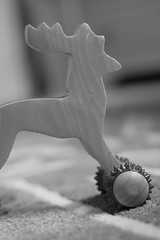The Canon 350D vs the Nikon D50
Have you been trying to figure out the differences between the Canon 350D vs the Nikon D50?
You're in luck.
In this head-to-head analysis, we'll compare these cameras and take a look at their strengths and weaknesses.
Since the two cameras are fairly evenly matched, we'll have to dig into some of the lesser-know features to compare them.
Let's get started with a feature list of the Canon 350D vs. the Nikon D50.
Feature Comparison


| Canon EOS 350D | Nikon D50 | |
| Megapixels | 8.0 | 6.0 |
| ISO Range | 100-1600 | 200-1600 |
| Autofocus | 7-area | 3-area |
| Max Shutter | 1/4000 | 1/4000 |
| Crop Factor | 1.6 | 1.5 |
| Continuous Shots | 3fps | 2.5fps |
| LCD Size | 1.8 inches | 2.0 inches |
| Memory Card | Compact Flash | SD |
| Special Features | Low ISO noise | Color capture |
Well, that's not exactly helpful is it? The two cameras are evenly matched. Let's take a closer look.
Canon Advantages
8 Megapixels
This is great for the photographer who wants to make large prints, and a drawback for anyone else.
It's a drawback because 8 megapixel files take up a lot of room on hard drives, and require powerful computers to review and edit.
You never want to send an 8 megapixel file via e-mail to a friend.
If you want to print at 20x30, then the Canon's 8 megapixels are a selling point over the Nikon's 6.
Black and White Photos
You can set the Canon 350D Rebel XT so that it takes photos in black and white, just like the Minolta Maxxum 5D.
Even if you don't think of yourself as a black and white photographer, this feature lets you experiment with it while getting instant feedback about your results.
The Nikon D50 only takes photos in color.
You can use a computer program to change any color photo into black and white, but the results won't be the same.
For black and white enthusiasts, there is no contest between the Canon 350D vs the Nikon D50. The Canon wins.
Small and Light
You want a portable SLR? The 350D is exactly that.
It is smaller and lighter than the Nikon D50, making it a better option for the photographer on the go.
The 350D compresses a lot of the camera controls to achieve this, which doesn't make it ideal for the large-hand crowd.
Depth of Field Preview
This feature is most important if you enjoy macro (or close-up) photography.
I will keep this a simple as possible: the aperture setting on your camera determines how wide the lens opens.
When you have the lens open wide, you are dealing with a shallow depth of field: anything in front of or behind the point of focus appears blurry.
When you have the lens opening narrow, you have a wide depth of field: everything appears in focus from foreground to background.
Macro photography involves a very limited range when it comes to depth of field, since depth of field is also affected by your proximity to your subject.
In this case, it's important to see what effect a narrow aperture will have on your depth of field.
To make this long explanation short, the Canon 350D has a depth of field preview feature so you can "see" the depth of field in the viewfinder, while the Nikon D50 does not.
Nikon Advantages
Large LCD
Since the Rebel XT is so compact, the LCD is reduced in size: only 1.8".
It may not seem to you like there is a huge difference between 1.8" and 2.0" but there is when you see the cameras side-by-side.
The Nikon's LCD is also incredibly colorful and bright, making it quite easy to see even in bright sunlight.
This LCD makes it very easy to review photos right after you take them.
Comfortable Grip
One of the Canon's strengths is also it's weakness.
The camera is so compact, that it makes it hard to hold. You really have to curl your fingers to hold onto it.
Since the Nikon D50 is larger, the camera grip is more comfortable.
While this makes no difference at all if you take photos for 30 seconds and then put the camera down, it really helps when taking photos for an extended period of time.
Price
If you don't need the extra 2 megapixels that the Canon offers, don't pay for them.
To be clear, it's about $50 or £50 a megapixel.
In the U.S. the Nikon D50 retails with a lens for about $ 670.00 and you can get your hands on a Canon for $ 780.00. In the UK, the D50 will run you £ 384.00 but you'll have to shell out about £100 more for the Canon at £ 470.00.
Since the two cameras are very similar to each other (except for the differences I've talked about here) you can save quite a bit getting the Nikon instead of the Canon.
Summary
We just covered a lot of gound comparing the Canon 350D vs the Nikon D50.
I'll summarize the key differences again here:
- If you want to make huge prints, the 350D is the way to go
- You can carry the 350D everywhere - great for travel photographers
- The 350D can take photos in black and white while the Nikon D50 can't
- The 350D has a depth of field preview and the D50 does not
- The Nikon has better ergonomics and is easier to user for long periods of time
- The D50 has a larger LCD than the 350D, making it easier to review photos and change menu settings
- The 6.1 megapixels on the D50 is plenty if you don't often make huge prints
If you'd like more detailed information about either one of these cameras, read the complete Canon 350D Guide or the Nikon D50 Guide.
User Reviews
I've added these links to use reviews so that you can find out what others think of them.
Keep in mind that most people just buy one camera, and are totally happy with it (unless it breaks on them).
While reviews might not help much with any comparative analysis, it is good to find out why people chose one camera over the other.
| Digital SLR Home | Nikon D50 Guide |






